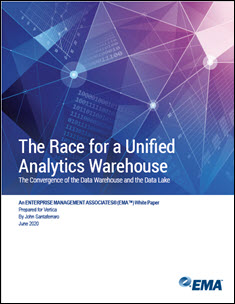 This white paper, “The Race for a Unified Analytics Warehouse,” from our friends over at Vertica, discusses how the race for a unified analytics warehouse is on. The data warehouse has been around for almost three decades. Shortly after big data platforms were introduced in the late 2000s, there was talk that the data warehouse was dead—but it never went away. When big data platform vendors realized that the data warehouse was here to stay, they started building databases on top of their file system and conceptualizing a data lake that would replace the data warehouse. It never did.
This white paper, “The Race for a Unified Analytics Warehouse,” from our friends over at Vertica, discusses how the race for a unified analytics warehouse is on. The data warehouse has been around for almost three decades. Shortly after big data platforms were introduced in the late 2000s, there was talk that the data warehouse was dead—but it never went away. When big data platform vendors realized that the data warehouse was here to stay, they started building databases on top of their file system and conceptualizing a data lake that would replace the data warehouse. It never did.
Data lake platforms quickly demonstrated the value of semistructured data. As data lakes grew in popularity, data warehouse vendors saw them encroaching on their territory, so they began to shift their databases to run on file systems and started finding ways to process semi-structured data.
This white paper includes the following sections that explore the growing importance of selecting the right data warehouse solution for your enterprise:
- The Race is On
- Requirements for the Unified Analytics Warehous
- Vertica – Crossing the Finish Line
- About Vertica
Within a few years, nearly every organization that ran a data warehouse also stood up a data lake. The two existed side by side. Initially, there was some data sharing between the two platforms, but not much more. Pressured by customer demands to run analytics across both the data lake and the data warehouse, vendors on both sides began working toward a more complete integration of a warehouse and lake.The race began.
Trusted by AT&T, Cerner, Uber, The Trade Desk, and many other data-driven organizations, Vertica is the unified analytics warehouse that solves three current market challenges that every organization faces. Despite the disappointment in Hadoop, HDFS data lakes represent a very significant investment for many companies, but the value is not equivalent to original expectations. Combined with the explosion of cloud object storage, organizations struggle even more to unify their data. In addition, organizations favor a multi-cloud or hybrid cloud and on-premises deployment strategy as they face the reality of cloud vendor lock-in, costs, and migration challenges. Finally, machine learning is no longer a data science project, but must be put into production to deliver the predictive analytics information in time to allow proactive actions.
Download the new white paper courtesy of Vertica, “The Race for a Unified Analytics Warehouse” to learn about the convergence of the data warehouse and the data lake.



